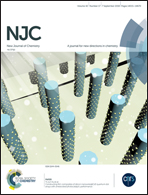Effect of counterions on anionic fluorocarbon surfactant micelles by dielectric spectroscopy
Abstract
The dielectric spectra of sodium perfluorooctanoate (NaPFO), ammonium perfluorooctanoate (APFO) and tetraalkylammonium perfluorooctanoate (C7F15COON(CnH2n+1)4, n = 1, 2, 3, 4, namely, TMPFO, TEPFO, TPPFO and TBPFO) were studied in the frequency range from 40 Hz to 110 MHz. An obvious dielectric relaxation was observed in each aqueous system whose low-frequency limit of relative permittivity (εl) was divided into two groups based on their dependence on concentration, except there were two relaxations for TBPFO. Furthermore, their relaxation mechanism was analyzed and attributed to the radial diffusion of the free counterions in the diffuse layer. What's more, combined with the average radius ![[R with combining macron]](https://www.rsc.org/images/entities/i_char_0052_0304.gif) of these micelles obtained on the basis of the Grosse's model, the difference between these two groups and their structural information were speculated. It was proved that the type of counterion has an important influence on the structure and properties of fluorocarbon surfactants.
of these micelles obtained on the basis of the Grosse's model, the difference between these two groups and their structural information were speculated. It was proved that the type of counterion has an important influence on the structure and properties of fluorocarbon surfactants.



 Please wait while we load your content...
Please wait while we load your content...